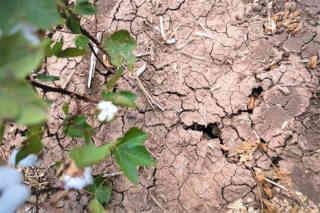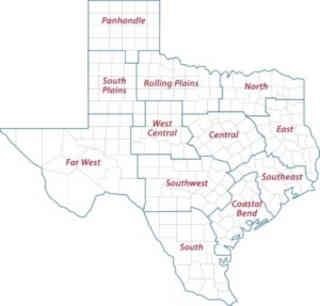By Adam Russell
Texas cotton growers in major production areas experienced widespread crop losses, and more acres are likely to be left unharvested due to poor plant development, according to Texas A&M AgriLife Extension Service experts.

The northern and southern High Plains produce the majority of Texas cotton. Generally, around 4.5 million acres of cotton are planted in the two regions. Around 60%, or 2.7 million acres are dryland while the rest have at least some irrigation.
Murilo Maeda, Ph.D., AgriLife Extension cotton specialist, Lubbock, said drought conditions have led to near-total failure of both regions’ dryland acres, and drought and extreme heat have put much of the regions’ irrigated fields in jeopardy of failure or abandonment, especially where irrigation capacity is limited.
A U.S. Department of Agriculture Farm Service Agency report indicates almost 70% of dryland and 35% of irrigated cotton acres in those two regions failed.
However, Maeda fears the report may be conservative. Most acres were clear failures, he said, but many acres produced crop stands that drought alone did not kill.
Those stands are in poor shape production-wise and may not be worth harvesting, he said. Many more fields may not be harvestable due to poor plant development due to drought.
“It certainly looks like it reflects the reality in dryland fields, but it may actually be lower than what we are seeing on the ground for the rest of the acres,” he said. “There’s just not a lot out there, and a lot of the fields still standing may not be harvested. It’s pretty brutal.”
Tough growing season for Texas cotton
Emi Kimura, Ph.D., AgriLife Extension cotton specialist, Vernon, said there are dryland fields in the Rolling Plains that received enough rain to survive, but yield potential is very low.
Some irrigated fields looked decent in her area, but plant development was similarly impacted by drought and heat, she said. Irrigated fields need some rainfall to meet plants’ water demands, and there was very little during the growing season.
Without moisture, plant development, boll count and fiber quality suffer, and extreme heat can exacerbate problems, she said.
Kimura said there has been one positive to the difficult drought conditions – low pest pressure. Producers have treated irrigated fields for insect pests like flea hoppers once or twice compared to several rounds of proactive sprays, which helped cut some input costs.
But now, a late-season problem – weeds – are abundant and growing rapidly in fields following good rain showers that delivered soil moisture to the region. Kimura said treatment will likely depend on the yield potential and individual producer’s management routines.
“It has been a tough growing season, but we hope this rain and cooler temperatures allows some producers to end the season on a high note,” she said. “Hopefully that will carry into the wheat season and we get off to a good start.”
Maeda said he worries about the regional cotton infrastructure, including gins and related businesses, that depend on production and processing. Cotton gins operate seasonally. They typically receive thousands of bales of cotton for processing following harvest.
The lack of cotton production could generate a longer-term ripple effect if gins do not run, and other support businesses are not able to withstand the losses.
“My concern is for the folks in the region who are reliant on cotton,” he said. “A bad season will affect producers, but the downstream impact to the infrastructure is what we’re worried about, because losing that type of capacity can take longer to recover.”
AgriLife Extension district reporters compiled the following summaries:
CENTRAL

Western parts of the district missed the bulk of the recent rainfall, but eastern areas reported 1 to 4.5 inches. Soil moisture remained very short. Overall, pastures and rangeland conditions were very poor but were beginning to green up due to the recent rain and cooler temperatures. Improved pastures were responding quickly to the recent moisture. Native grasslands have been slower to respond, but improvements were noted. Overgrazed pastures were still struggling with livestock quickly consuming any new growth. Cattle producers were still supplementing with hay and were concerned about the winter forage outlook. Most stock tanks received little runoff. Livestock were in poor to fair condition. Nearly 80% of cotton was harvested.
ROLLING PLAINS
The district received rain and cooler temperatures. Rainfall amounts ranged from 1 inch to almost 8 inches, but most areas received multiple inches. Soil moisture improved as cloudy days and cooler temperatures followed the storm systems. Despite the rainfall, stock tanks were still pretty low or dry in some areas. Pastures and rangelands were greening up some. Cotton was blossoming, but most fields looked below average. Sorghum looked fair with harvest nearing. Producers were preparing fields for wheat and late Sudan grass plantings. Producers continued to feed livestock. Producers hoped to get a late hay cutting before fall.
COASTAL BEND
Scattered rains across the district improved topsoil and subsoil moisture in some areas, but other areas remained dry. Rangeland and pasture conditions were expected to improve in areas that received rain. Rain delayed harvest of remaining cotton fields. Some cotton plantings were zeroed out, and stalk destruction was occurring as weather permitted. Rice harvest was near completion. Some sesame was maturing, and harvest was expected soon on the earliest planted fields. Livestock producers were searching for hay. Some producers should make at least one cutting of hay following the moisture recently received. Cattle sales continued, and prices remained high.
EAST
Much-needed rain fell across the district with as much as 7 inches received in some areas. A few counties reported only receiving a quarter inch of rain. Pasture and rangeland conditions were poor to fair. Subsoil conditions were short to adequate. Topsoil conditions were adequate. Producers hoped the rainfall would help them get another hay cutting. Cattle markets remained strong. Livestock were doing fair to good. Armyworms were reported in multiple counties.
SOUTH PLAINS
Sporadic showers delivered 0.5-2 inches of rain, but more was needed. Temperatures were mild. A few farmers started planting wheat, but the majority were waiting for more moisture. A few sunflower fields were close to harvest. Pasture and rangeland conditions improved slightly, but cattle diets were still being supplemented.
PANHANDLE
A general rainfall delivered significant amounts of rainfall to some areas. Soil moisture conditions were short but improved for wheat planting. Producers looking for fall wheat pasture should begin planting soon. The rain should also help late-season corn and grain sorghum development. Some grain sorghum fields were starting to color. Rangeland and pasture were in poor condition but should improve.
NORTH
Topsoil moisture throughout the district was adequate to surplus. Most areas reported 0.5-9 inches of rain. Some ponds that were dried up were full or almost full. Pastures immediately started to green up with moisture and milder temperatures. Cotton bolls opened, but fields still looked poor. Remaining soybeans looked poor as well. Tree conditions continued to decline despite the recent rainfall. Cattle and other livestock inventories continued to decline with more culling. Insect and disease pressure was minimal.
FAR WEST
The average daytime high temperature was 87 degrees, and the average nightly low was 70 degrees. A pop-up shower delivered trace amounts of rain up to 1 inch in the higher elevations. In the southwest, monsoonal rains were widespread across the district and caused flash flooding. Pasture conditions and surface water levels continued to improve immensely. Weeds were providing grazing for cattle, which could slow herd sell-offs. Cotton fields matured quickly, and a few cotton bolls began opening in a couple of earlier planted fields. Several fields of recently planted hay grazer began to emerge. Producers were monitoring pecan weevils. Pest pressure was heavy in alfalfa.
WEST CENTRAL
Some areas received isolated rains. Cooler temperatures and overcast skies provided some relief. Crops were still in poor condition. A few producers were plowing fields and hoping for more rain for winter forage plantings. Cotton was maturing quickly. Some armyworm infestations were reported in irrigated forages. Many dry ponds were cleaned out by producers. Pastures had little to no grazing. The local sale barn had a much lighter run of cattle.
SOUTHWEST
Scattered rains were reported with many areas receiving 1-3 inches of rain. The added moisture started pasture and rangeland green-up, but more will be needed to restore forages. Supplemental feeding of livestock continued.
SOUTH
All areas reported rainy weather and mostly adequate soil moisture levels. Rainfall amounts ranged from zero up to 6 inches. Temperatures were cooler. Irrigation pivots were turned off in some areas. Strawberry and fall vegetable fields were being prepared. Some fields and pastures were saturated with rain. Cotton fields were being harvested or nearing defoliation. Some producers were shredding cotton stalks. Wet conditions were preventing cotton bale and module pickups. The peanut crop continued to develop under irrigation, and some fields showed signs of nitrogen deficiencies. Watermelon and cantaloupe were in good condition. Rains were beneficial for citrus and sugarcane. Sesame harvest was nearing completion. Rainfall was improving pasture and rangeland conditions, but some areas were bouncing back slowly. Forage producers were watching for armyworms. Supplemental feeding of livestock declined over the past two weeks, but some producers continued to feed hay. Hay and feed prices remained high. Stock tanks were full. Some hay producers cut and baled while others were expecting to cut and bale in a few weeks. Some were planting haygrazer to cut in the fall. Cattle sales were declining, but prices remained steady.
Source : tamu.edu